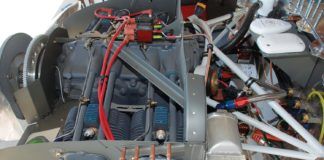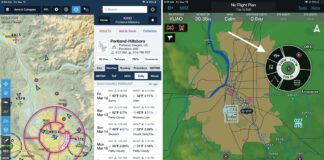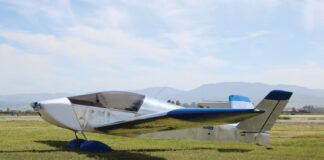Last month, we started to look at the stability and control characteristics of trikes. We saw that trikes behave very differently than conventional airplanes because of the large vertical offset between the wing and the center of gravity, and got a look at how controlling pitch with weight shift differs from using aerodynamic control surfaces.
We now turn our attention to one of the most important aerodynamic characteristics of a trike wing: its pitching moment behavior.
On a conventional airplane, the pilot can change the pitching moment generated by the airflow over the flying surfaces. Moving the stick deflects control surfaces that change the shape of the airplane and thus change the aerodynamic forces acting on it. A trike pilot cannot do this. Moving the control bar shifts the CG fore and aft relative to the wing, but does not change the shape of the wing.
As we saw last month, this inability to change the shape of the wing means that the pilot has zero pitch-control authority if the wing is unloaded due to a down gust or an overshoot caused by an aggressive nose-down control input. If the wing unloads, the pilot cannot command the wing to a higher angle of attack to regain lift. The ability of the vehicle to recover to positive lift is entirely dependent on whether the wing itself generates a nose-up moment at zero lift.
The importance of this was discovered the hard way during the early years of hang gliding. At first, the rule in hang gliding was “don’t fly any higher than you are willing to fall.” Simple Rogallo wings became the primary form of hang gliders in use. When flown very low and slow, they worked acceptably. Flights were short, and crashes were gentle enough to be survivable.
Inevitably, glider designers started using better materials, improved aerodynamic efficiency, and made higher-performance gliders. As pilot skill increased, some hang glider pilots began to violate the “no higher than you are willing to fall” rule and began doing soaring flights. Soon there were a series of accidents where the glider lost lift due to a down gust or nose-down control input and locked into a low angle of attack dive, often all the way to the ground.
This phenomenon, called “luffing in,” was caused by the flexible nature of early hang glider wings. They had no ribs or battens to allow any portion of the wing to generate down load, so at some critical angle of attack, the air pressure across the sail was lost, and the sail lost lift. As we have already seen, due to the lack of control power in the absence of wing load, the pilot had no way to recover.
The solution was to add battens and bracing to control the shape of the wing. The battens kept the sail from going limp at low angles of attack. Bracing held the tip battens in place to produce washout in the wing, so the tips would produce a down load at low angles of attack. This down load at the tips produced the nose-up moment required to drive the angle of attack back up and regain lift.
These modifications ensured that the wing would produce a nose-up moment when unloaded. They do not change the fact that a trike or hang glider is unstable at negative lift, but the positive zero-lift pitching moment makes recovery from a momentary unload possible.
Examples:
Figures 1 and 2 show the characteristics of three example trikes with the same characteristics except for the zero-lift pitching moment (Cm0) of the wing. All three aircraft are trimmed to fly at the same airspeed (65 knots), so they all trim at different control bar angles. (Please note that the specific airspeeds and angles of attack refer to the example vehicles and are not universal.)
Looking first at Figure 1, we can see that all three are trimmed at the same angle of attack (AOA).
For the trike with a positive Cm0, the curve shows a stable slope of pitching moment vs. AOA around the trim point. The aircraft becomes neutrally stable at just below 1 degree AOA, and is unstable below that. Because of the positive Cm0 of the wing, the net pitching moment is nose up to several degrees AOA below zero. This aircraft can fly safely as long at the pilot does not attempt to deliberately fly inverted or force it to negative G.
Looking next at the curve for zero wing Cm0, we can see that the stability and trim situation is not as good. The aircraft is still stable around the trim angle of attack, but the slope is shallower than that of the positive-pitching-moment wing and the aircraft is thus less stable.
The region of low angle of attack instability starts at a higher angle of attack. Also note that at zero angle of attack, the vehicle is unstable and the pitching moment is zero. There is no net moment driving the wing back to positive lift. Because of the instability, any pitch rate will tend to increase. If the machine ever reaches this angle of attack with a nose-down pitch rate, it will tuck under uncontrollably. This is very dangerous.
Even more dangerous is the machine with a negative Cm0 wing. As the figure shows, this vehicle is neutrally stable at the trim point and will tuck under at an angle of attack less than 2 degrees below the trim point.
Figure 2 shows pitching moment vs. airspeed for the same three trikes. Note in particular that the negative-pitching-moment aircraft will start to tuck under at airspeeds slightly above the trim point.
The example we just looked at is for all three aircraft trimmed at the same airspeed. To see just how dangerous a negative-pitching-moment wing on a trike can be, look at Figures 3 and 4.
Looking at Figure 3, we can see how the characteristics of this machine change as the trimmed angle of attack changes. With the bar pushed out to trim at the angle of attack for 45 knots (about 7.5 degrees AOA), the aircraft is reasonably well behaved. It’s stable around the trim point. It still exhibits a tuck-under at 1 degree AOA, but there is an angle of attack range with strong nose-up moments below the trim point that will tend to arrest any dangerous nose-down pitch rate. The tuck-under angle of attack is far enough below the trim point that it’s unlikely the aircraft will get driven there by a gust.
As the pilot pulls in the bar to trim to 60 knots, the situation changes. The aircraft is now much less stable around the trim point. The nose-up pitching moment at lower angles of attack is very small, and tuck-under occurs less than 3 degrees AOA below the trim point. Flying at this airspeed, the machine will be very sensitive in pitch, and a relatively small movement of the control bar, or a down gust can easily precipitate a nose-down loss of control.
If the pilot attempts to trim this aircraft to fly at 75 knots, it is on the brink of disaster all of the time. Any change in angle of attack will cause the nose to drop, and if the angle of attack change is negative, the aircraft will tuck under.
What makes an aircraft like this particularly dangerous is the fact that it is quite flyable at lower airspeeds. It’s entirely possible for a pilot to fly this machine successfully as long as the airspeed is kept low. This can produce an unmerited confidence in the airworthiness of the craft. When the pilot gets a little more adventurous and tries to fly faster or initiate a dive, the rapid degradation of pitch stability and control will quickly lead to an uncontrollable tuck-under and a severe mishap.
Next month we will look at the effects of mast height, and other parameters on the safety and controllability of trikes.

![]()
Barnaby Wainfan is a principal aerodynamics engineer for Northrop Grumman’s Advanced Design organization. A private pilot with single engine and glider ratings, Barnaby has been involved in the design of unconventional airplanes including canards, joined wings, flying wings and some too strange to fall into any known category.

















